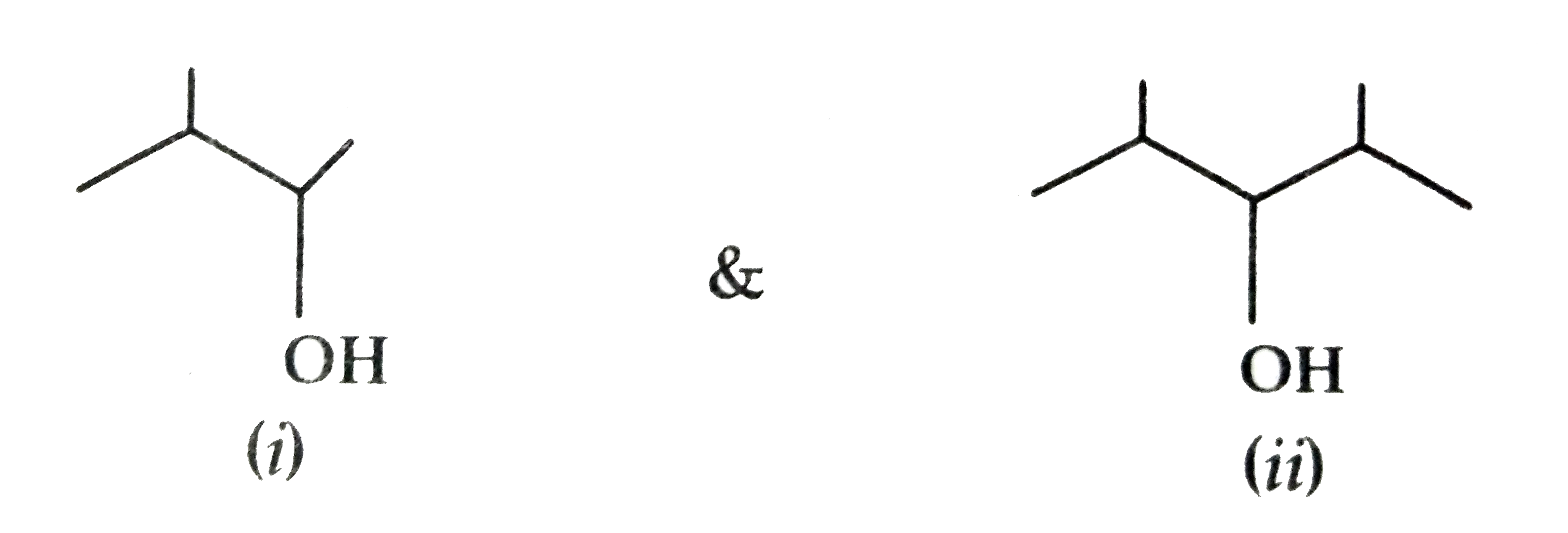Write the structure of all the alkenes that can be hydrogenated to from 2-mrthyl pentane.
To determine the structures of all the alkenes that can be hydrogenated to form 2-methylpentane, we will follow these steps:
Step 1: Write the Structure of 2-Methylpentane
2-methylpentane has a five-carbon chain with a methyl group attached to the second carbon. The structure can be represented as follows:
CH3|CH3−CH−CH2−CH3|CH2
Step 2: Identify Possible Positions for the Double Bond
In alkenes, the double bond can be placed between any two carbon atoms. For 2-methylpentane (C5H12), we can place a double bond in the following positions:
- Between C1 and C2
- Between C2 and C3
- Between C3 and C4
- Between C4 and C5
Step 3: Draw the Alkenes
Now we will draw the alkenes for each of the positions identified above:
1. Pent-1-ene (double bond between C1 and C2):
CH3∣CH2=CH−CH2−CH3
2. Pent-2-ene (double bond between C2 and C3):
CH3∣CH3−CH=CH−CH2−CH3
3. Pent-3-ene (double bond between C3 and C4):
CH3∣CH3−CH2−CH=CH−CH3
4. Pent-4-ene (double bond between C4 and C5):
CH3∣CH3−CH2−CH2−CH=CH2
Step 4: Identify Isomers with Methyl Group
Next, we need to consider the isomers that include the methyl group at the second position:
1. 2-Methylpent-1-ene:
CH3∣CH2=CH−CH2−CH3
2. 2-Methylpent-2-ene:
CH3∣CH3−CH=CH−CH2−CH3
3. 3-Methylpent-2-ene:
CH3∣CH3−CH2−CH=CH−CH3
4. 3-Methylpent-3-ene:
CH3∣CH3−CH2−CH2−CH=CH2
Summary of Alkenes
The alkenes that can be hydrogenated to form 2-methylpentane are:
1. 2-Methylpent-1-ene
2. 2-Methylpent-2-ene
3. 3-Methylpent-2-ene
4. 3-Methylpent-3-ene
2-methylpentane has a five-carbon chain with a methyl group attached to the second carbon. The structure can be represented as follows:
In alkenes, the double bond can be placed between any two carbon atoms. For 2-methylpentane (C5H12), we can place a double bond in the following positions:
- Between C1 and C2
- Between C2 and C3
- Between C3 and C4
- Between C4 and C5
Now we will draw the alkenes for each of the positions identified above:
CH3∣CH2=CH−CH2−CH3
CH3∣CH3−CH=CH−CH2−CH3
CH3∣CH3−CH2−CH=CH−CH3
CH3∣CH3−CH2−CH2−CH=CH2
Next, we need to consider the isomers that include the methyl group at the second position:
CH3∣CH2=CH−CH2−CH3
CH3∣CH3−CH=CH−CH2−CH3
CH3∣CH3−CH2−CH=CH−CH3
CH3∣CH3−CH2−CH2−CH=CH2
The alkenes that can be hydrogenated to form 2-methylpentane are:
1. 2-Methylpent-1-ene
2. 2-Methylpent-2-ene
3. 3-Methylpent-2-ene
4. 3-Methylpent-3-ene
Topper's Solved these Questions
- ALKANES AND CYCLOALKANESBOOK - CENGAGE CHEMISTRY ENGLISHCHAPTER - ALKANES AND CYCLOALKANESEXERCISE - Paragraph for problem
24 Videos
- ALKANES AND CYCLOALKANESBOOK - CENGAGE CHEMISTRY ENGLISHCHAPTER - ALKANES AND CYCLOALKANESEXERCISE - True and False
1 Videos
- ALKANES AND CYCLOALKANESBOOK - CENGAGE CHEMISTRY ENGLISHCHAPTER - ALKANES AND CYCLOALKANESEXERCISE - SOLVED EXAMPLES
19 Videos
- ALKENES AND ALKADIENESBOOK - CENGAGE CHEMISTRY ENGLISHCHAPTER - ALKENES AND ALKADIENESEXERCISE - Single correct Answer
14 Videos
Similar Questions
Write the structure of 2-aminotoluene.
View SolutionWrite structures of all the alkenes which on hydrogenation give 2-methylbutane.
View Solution(a) Identify the chiral molecule in the following pair :

(b) Write the structure of the product when chlorobenzene is treated with methyl chloride in the presence of sodium metal and dry ether .
(c) Write the structure of the alkene formed by dehydrohalogenation of 1-bromo-1-methylcyclohexane with alcoholic KOH.
View SolutionWhat are alkyl groups ? Write the structures of all possible alkyl groups which can be obtained from propane and butane.
View SolutionWrite the structure of 2hydroxybenzoic acid.
View SolutionWrite the structure of 2-Methylpropan-2-ol
View SolutionWrite the structural formulae of all isomers of hexane.
View SolutionWrite the structure of 2.4-dinitrochlorobenzene.
View SolutionWrite the Lewis structure of hydrogen peroxide .
View SolutionHow many isomeric structural alkene on catalytic hydrogenation gives 3-Methyl hexane.
View Solution
